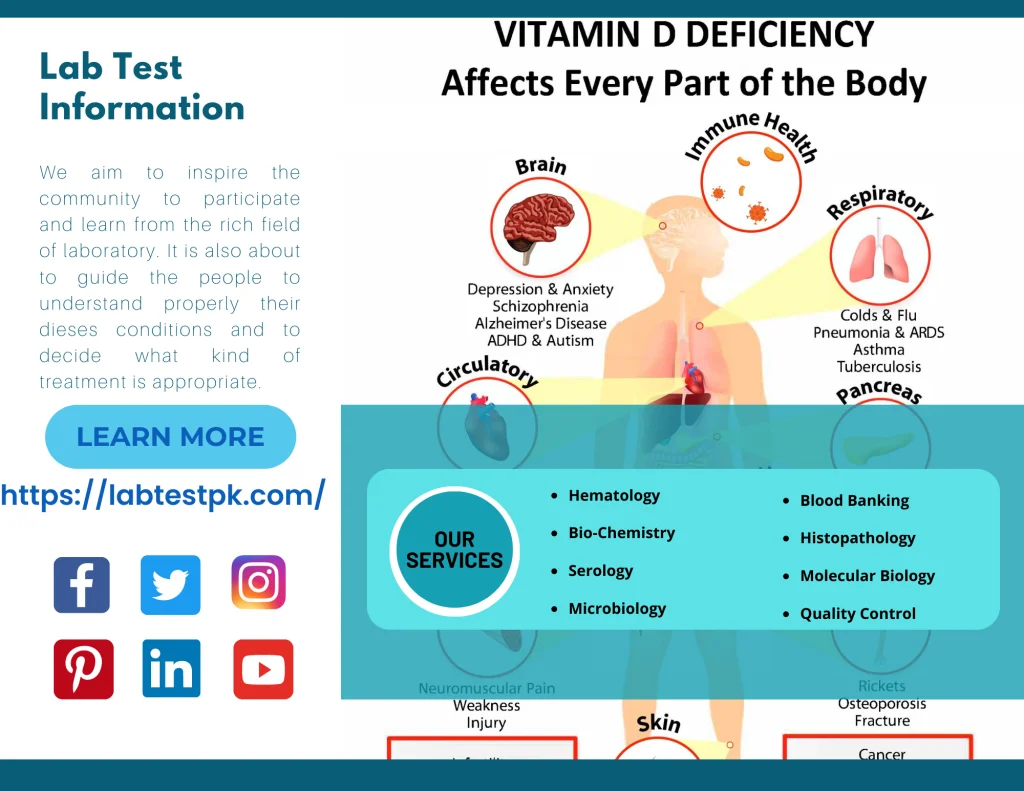Vitamin D
Vitamin D is also called calciferol. It is an important fat-soluble vitamin. Vitamin D is a group of fat-soluble secosteroids responsible for increasing intestinal absorption of calcium, magnesium, and phosphate and many other biological effect. It is also produced endogenously when sunlight ultraviolet (UV) rays phosphate, and many other biological effects strike the skin and trigger vitamin D synthesis.
Types Of Vitamin D:
There are two main types of vitamin D:
- Vitamin D2
- Vitamin D3
Vitamin D2:
Vitamin D2 is also called Ergocalciferol Vitamin D2 is mostly present in Supplements and some foods.
Vitamin D3:
Vitamin D3 is also called cholecalciferol Vitamin D3 is naturally produced in the Skin on exposure to sunlight and it is also present in animal-based foods and supplements.
Vitamin D:
Vitamin D2 and Vitamin D3 convert into 25 hydroxy vitamin D (Also called Calcidial) in the liver 25-hydroxyvitamin D converts into the active form1, 25-dihydroxy vitamin D (Also called Calcitriol) in the kidneys.
Both 25-hydroxy vitamin D and 1, 25-hydroxyvitamin D can be measured in blood. But 25-hydroxyvitamin D is the major form of vitamin 1 present in blood and due to its high concentration and the long half-life is used commonly to diagnose vitamin D deficiency. If you access and screen form of vitamin D then you will test 25 hydroxyvitamin D in your blood.
Functions of Vitamin D:
Vitamin D helps maintain phosphorous and calcium levels in the blood. Vitamin D helps in the absorption of calcium in the intestine. Keeping bones and teeth strong help in muscle contrition immune system, and helps in improving Cardiac functionary secretions of hormones. Vitamin D provides anti-cancer effects and helps in brain development.

Diet Rich in Vitamin D:
- Exposure to Sunlight is the rich Source
- Beef liver
- Fortified milk
- Mushrooms
- Eggs
- Butter
- Oranges Juice
- Fatty fish
- Carrots
- Papaya cheese
- Sweet potato and Mangoes Meat
Symptoms of Vitamin D:
- Mood Swing Overweight
- Joint pain
- Dry Skin and Hair loss
- Fatigue and High blood pressure
- Infertility
- Respiratory problems
- Muscle weakness
- Anorexia and poor Apatite
- Depression, Rickets,
- Joint pain
Purpose:
To diagnose the actual cause of bone abnormalities. To monitor the treatment of Vitamin D deficiency, To check out the vitamin D levels in chronic diseases related to skin or asthma.
Normal Range of Vitamin D:
The normal range of vitamin D is:
20 to 40 ng/mL
Causes of High Vitamin D in Blood:
Intake of large doses of vitamin D supplements non by diet or sun exposure.
Causes of Low Vitamin D in Blood:
- Lack of exposure to sunlight.
- Does not Contain Consume enough Vitamin D.
- Liver and Gallbladder dysfunction.
- Regular use f Sunblock.
- Metabolic Abnormalities in absorption.
How to Performed?
A blood sample is needed.
Materials:
- Ichroma vitamin D
- Ichroma reader
- Blood serum or serum, Plasma
- Vitamin D kit
- Buffers solution
- Ida Tripp
Procedure:
Collect the blood sample from 3 to 5ml. Centrifuge the blood sample. Keep the seabed test cartage, releasing, and detection buffers at 25 degrees Celsius for at least 30 mins before the test.
The test procedure with the desk cartridge into the All chambers log. Transfer 50 microliters of releasing buffer into the sample mixing truth Transfer the 50 microliters of the sample using a new step to the sample mining tube containing releasing buffer and mix tube containing well by pipetting 10 times. Leave the sample in an added tube in the inserting tube block at 35°C for 5 minutes. After 5 minutes add 100 ml of detection buffer using a new pipette tip to the tube containing the releasing buffer and sample mixture. Min well by pipetting ten times, and leave it in the inserting strove lock again at 35 degree Celsius, for 15 minutes Inant the true block fully to trigger the high chambers timer. after 15 minutes put out half of the test cartridge from the I chamber on 25 microliters from the whale. mixture dispenser it into the sample well on the test cartridge and insert the test cartridge. new fully leave the sample loaded test cartridge at 35°C or 8 minutes. After 8 minutes immediately insert the Sample loaded test cartridge into the test cartridge. holder press the Select button on the reader to start the Scanning process. The test will be displayed on the screen.


[…] K is produced by intestinal bacteria, Vitamin K deficiency,Common in newbornintramuscular treatment is recommended at […]